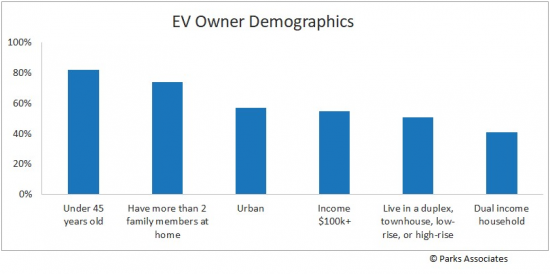 |
市场调查报告书
商品编码
1107252
电动汽车和智能家居Electric Vehicles and the Smart Home |
||||||
总结
随着世界各国政府、主要汽车製造商和大型科技公司都投资于电动汽车,该市场正在增长。本报告考察了电动汽车的普及率,包括电动汽车车主的充电和使用习惯、非车主的购买意向以及购买障碍。它还分析了消费者对联网汽车的兴趣以及将电动汽车用作储能设备的情况。

分析师意见
“未来几年,能源和互联技术行业的公司将确定电动汽车的崛起将如何影响其各自的行业和客户群,并使他们的解决方案成为新现实的一部分。”它制定成为一个部门的战略将是一个艰难但关键的时刻。”- Chris White,Parks Associates 高级分析师
内容
执行摘要
- 电动汽车认知度高
- 电动车车主人口统计
- 电动车车主体验
- 按地点划分的每月电动汽车充电次数
- 技术亲和力与对电动汽车的兴趣之间的相关性
- 电动汽车和智能家居应用的大跨界
- 家居节能改造
- 使用电力公司提供的特殊能源计划
- 协调或允许电力公司将电动汽车充电延迟至高峰时段结束
电动汽车进入汽车市场
- 拥有的车辆类型
- 插电式电动汽车的所有权
- 按车辆类型划分的车辆拥有量
- 未来 12 个月内购买汽车的可能性
- 车辆购买申请人的购买流程
- 非车主购买电动汽车的意愿很高
- 未来购买电动汽车的可能性
- 所有购车者中最有可能的类型(2021 年第四季度)
- 购买意向 按车型划分的电动汽车购买意向
EV 概述和特点
- 对电动汽车的高度认可
- 通过所有权/购买意图了解电动汽车
- 活跃的汽车购买者对电动汽车的认知度很高
- 对独特电动汽车技术的研究量
- 未来各车型对电动汽车的认知度较高
- 按人口统计因素划分的电动汽车认知度高
- 按性别划分的电动汽车认知度
- 不同种族的电动汽车认知度
- 非电动车车主对电动汽车的态度
EV 价值主张
- 了解电动汽车的优势
- 当今先进电动汽车功能的价值
- 正在开发的电动汽车功能的价值
- 对电动汽车“互联”功能的认可
- 电动汽车的价值——“互联”汽车技术
当前的 EV 车主
- 按人口和住房因素划分的电动汽车拥有率
- 有孩子的家庭拥有的车辆
- 家庭规模拥有的车辆
- 介绍部分拥有的车辆
- 电动汽车车主的智能家居设备拥有率
- 安全系统的电动汽车所有权
- 电动车车主的节能行为细分
- 电动汽车车主家庭能源设备拥有率
电动车车主的经验和观点
- 电动车车主体验:净推荐值
- 在 EV 中执行驾驶任务的频率
- 电动车车主面临的问题:期望与现实
- 电动汽车车主对能源计划的认识
- 电动汽车车主的能源计划使用
- 以前用于电动汽车车主的能源计划
- EV专项项目信息来源频道
- 经销商在购买时提供的优先主题
充电体验与趋势
- 电动汽车充电频率:同比
- 电动汽车长期充电频率
- 电动汽车充电频率:按地点
- 电动汽车的优先充电地点
了解冷漠:购买奖励和抑制
- 为不拥有或计划拥有电动汽车的消费者提供购买奖励
- 电动汽车购买激励量化:充电站普及
- 量化电动汽车购买激励措施:减税
- 量化购买电动汽车的激励措施:按收入减税
- 量化电动汽车购买激励措施:每月节省燃料
- 阻碍购买电动汽车的因素
- 按种族/民族划分的阻碍购买电动汽车的因素
- 按性别划分的阻碍购买电动汽车的因素
- 按收入划分的抑制购买电动汽车的因素
- 阻碍有孩子的家庭购买电动汽车的因素
- 按节能行为细分抑制购买电动汽车的因素
- 按居住地区划分的阻碍购买电动汽车的因素
购买者:可能购买电动汽车的消费者
- 希望购买电动汽车的人拥有的车辆
- V 按自有车辆类型划分的购买意向
- 电动汽车车主和潜在买家之间的技术亲和力
- 智能家居和安全系统的所有权
- 协调或允许电力公司将电动汽车充电延迟至高峰时段结束
- 家居节能改造
- 按人口统计和住房因素划分的电动汽车车主和潜在购买者细分
电动汽车爱好者想要的汽车类型
- 潜在买家偏爱的车辆类型(按收入)
- 电动汽车车主有购买意向的车辆和购买意向细分市场
- 希望购买电动汽车的有孩子的家庭首选的车辆
- 按小区购买意向车型
附录
SYNOPSIS:
With governments around the globe, major car makers, and big tech all investing in electric vehicles, the market is primed for growth. This research measures adoption of EVs, including the charging and usage habits of owners, purchase intention for non-owners, and examines the barriers to buying. It also analyzes consumer interest in utilizing their EV as a connected car and as an energy storage device.

ANALYST INSIGHT:
"The next few years represent a challenging but critical time for players in energy and connected technology industries to determine how the rise of EVs will impact their industries and customer segments, and strategies to ensure their solutions will be part of the new reality." - Chris White, Senior Analyst, Parks Associates.
Table of Contents
Executive Summary
- High Familiarity with Electric Vehicles
- EV Owner Demographics
- EV Owner Experience
- Monthly EV Charging Frequency by Type of Location
- Tech Affinity Correlates with of EV Interest
- Major Crossover Between EV and Smart Home Adoption
- Modified Their Home for Energy Savings
- Use Special Energy Programs Offered by Electricity Provider
- Willingness to Adjust or Allow Utility to Delay EV Charging Until After Peak Periods
EVs Entering the Vehicle Market
- Type of Vehicle Owned
- Ownership of Plug-in Electric Vehicle
- Vehicle Ownership by Types
- Likelihood of Purchasing a Vehicle in Next 12 Months
- Vehicle Intenders' Shopping Process
- High Intention of Purchasing EV Among Non-Owners
- Likelihood of Purchasing EV in the Future
- Most Likely Type Among All Vehicle Intenders (Q4/2021)
- EV Purchase Intention by Type of Vehicle Intend to Buy
Overall Perceptions of EVs and their Features
- High Familiarity with Electric Vehicles
- Familiarity with EVs by Car Ownership & Purchase Intention
- High Familiarity with EVs by Active Vehicle Shoppers
- Quantity of Research of Electric Vehicles Unique Technology
- High EV Familiarity by Type of Future Vehicle
- High Familiarity with EV by Demographic Factors
- EV Familiarity by Gender
- EV Familiarity by Ethnic Heritage
- Attitudes Toward Electric Vehicles Among Non-EV Owners
The Value Proposition of EVs
- Familiarity with Electric Vehicle Benefits
- Value of Advanced EV Features Today
- Value of EV Features in Development
- Familiarity with Electric Vehicles "Connected" Features
- Valuable Features of Electric Vehicles - "Connected" Car Tech
Today's EV Owners
- EV Ownership by Demographic and Housing Factors
- Type of Vehicle Owned by Children at Home
- Type of Vehicle Owned by Household Size
- Type of Vehicle Owned by Adoption Segment
- Smart Home Device Ownership by EV Ownership
- Security System Ownership by EV Ownership
- Energy Saving Actions Segments by EV Ownership
- Home Energy Equipment Ownership by EV Ownership
EV Owner Experiences and Perspectives
- EV Owner Experience: Net Promoter Score
- Frequency of Performing Driving Tasks with an EV
- EV Ownership Pain Points: Expectations vs. Reality
- Energy Program Familiarity by EV Ownership
- Energy Program Use by EV Ownership
- Previously Used Energy Program by EV Ownership
- Information Source Channel of EV Special Plan
- Preferred Topic Provided by Dealers During Purchase
Charging Experiences and Preferences
- Frequency of Charging Electric Vehicles, YoY
- Electric Vehicles Long Time Charging Frequency
- Electric Vehicles Charging Frequency by Locations
- Preferred Charging Location of Electric Vehicles
Understanding the Disinterested: Purchase Incentives and Inhibitors
- Purchase Incentives for Consumers Who Do Not Own Or Intend To Own an EV
- Quantifying EV Purchase Incentives: Widespread Availability of Charging Stations
- Quantifying EV Purchase Incentives: Tax Break
- Quantifying EV Purchase Incentives: Tax Break by Income
- Quantifying EV Purchase Incentives: Monthly Fuel Savings
- Electric Vehicle Purchase Inhibitors
- Electric Vehicle Purchase Inhibitors by Race or Ethnicity
- Electric Vehicle Purchase Inhibitors by Gender
- Electric Vehicle Purchase Inhibitors by Income
- Electric Vehicle Purchase Inhibitors by Children at Home
- Electric Vehicle Purchase Inhibitors by Energy Saving Action Segments
- Electric Vehicle Purchase Inhibitors by Residency Area
Intenders: Consumers Likely to Buy an EV
- Type of Vehicle Owned Among EV Intenders
- EV Purchase Intention by Type of Vehicle Owned
- Tech Affinity Among EV Owner & Intender Segments
- Smart Home and Security System Ownership
- Willingness to Adjust or Allow Utility to Delay EV Charging Until After Peak Periods
- Modified Their Home for Energy Savings
- EV Owner & Intender Segment by Demographic and Housing Factors
The Types of Vehicles EV-intenders Want
- Type of Vehicle Preferred by EV Intenders Grouped by Income
- Type of Car Intend to Buy by EV Owner & Intender Segment
- Type of Vehicle Preferred by EV Intenders Grouped by Children at Home
- Type of Car Intend to Buy by Residency Area













